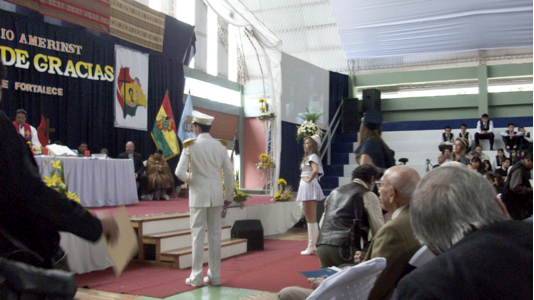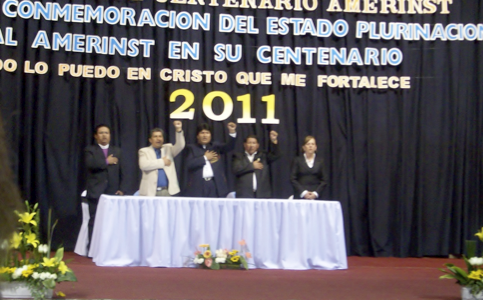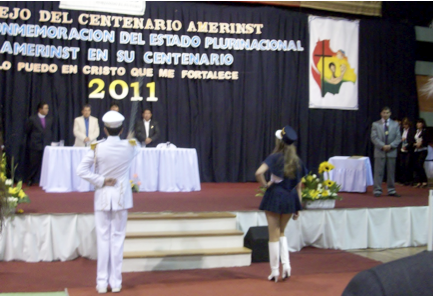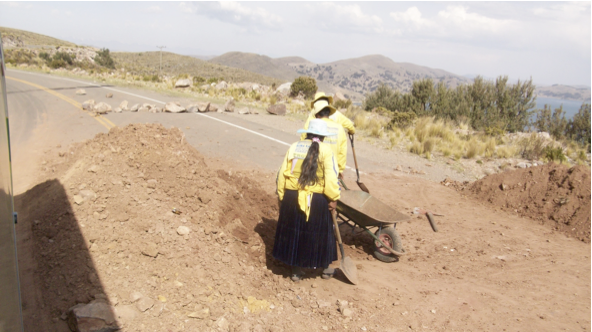Face to face with Evo and a bloqueo in 24 hours

It was clearly a “you-must-come” kind of invitation. The Bolivian Bishop, Javier Rojas, would officiate. And Bolivian President Evo Morales, a close pal of the bishop’s, might make an appearance! So we said Sure, we’d be delighted to attend.
The most important day of the four-day extravaganza would be Wednesday – less than four days to get ready and travel the 200 miles to Cochabamba! I thought: OK, I can wear my fabulous purple velvet Aymara skirt, recently purchased for special occasions. But my only jacket is now two sizes too big for me, and shoe options are a pair of tatty Skechers I garden in, or my hiking boots. Jeff’s lost so much weight we decided to buy a sweater vest in the hope of concealing the extra inches of waistband cinched up by his belt.

The trip required a three-hour bus ride to La Paz on Monday, followed by a 7-hour bus ride Tuesday through the High Andes. The highest point was 15,600 feet! The clouds below us were glorious.
La Paz and Copacabana are in the west central part of Bolivia. Cochabamba, at an elevation of about 8,500 feet, is nearer the heart of Bolivia. It looks and feels like south Florida in June – warm, humid, and lush with blooming trees, shrubs, vines, and flowers (it’s springtime here!). Flocks of parakeets hang upside down to sip nectar from colossal, purple-flowering trees that abound there. In fact, looking down as we descended from the mountains, the whole city is purple thanks to these exotic trees!

We arrived late Tuesday afternoon and settled into our tiny but comfortable hostel room. Early Wednesday we joined the throngs of uniformed students, proud parents and relatives, and carefully coifed dignitaries for a worship service loaded with pomp, babes in high boots (see photos!), and starchy ceremonies honoring scores of famed and/or retired faculty. Quite a to-do!

At mid-morning, hundreds of students, and hundreds more visitors packed into the green space within the well groomed 200+-acre campus. There, groups of urgently proud, well rehearsed students crammed into booths made of canvas, reeds, or indigenous fabrics, and recited the cultural, economic, social or agricultural histories of Bolivia’s eight departmentos, or provinces. They clamored to hand us samples of regional food, and miniatures of regional ceramics, hats, and textiles. The kids had worked so hard we felt compelled to eat most of the food we were offered. Because we are American, and frankly, white, the kids and their parents and teachers handed us a lot of samples. Plus variations. And seconds. And thirds. With different sauces …
Then it was time for lunch, always a huge meal in Bolivia. The menu included rice, three of the supposedly 2000+ varieties of Bolivian potatoes, choklo (giant, chewy kernels of corn off the cob), a salad, a fried banana, and a spicy, tender chunk of pork big enough to feed a Bolivian family of five! We were ushered to the high table with all the important guests. Though already stuffed, we ate a few bites: Delicious!
Rest assured nothing goes to waste in Bolivia. The school’s vast staff bagged many days of meals for their families!
We walked about four miles back to our hostel and rested up for the grand evening ahead. Strolling back to the Instituto Americano, an armed motorcade sped past us. It was a pretty sure bet: Evo Morales would attend!
The raised and roped press pen near the stage was packed with more than 25 reporters and cameramen. An hour after the scheduled start time, the student band streamed in, drums rolling. A troupe of 12 beaming, shapely female students in uniforms of wayyy short skirts and high boots flanked President Morales, followed by armed guards, followed by uniformed, high-ranking military men, shoulders piled with brocade epaulets and bandoliers, followed by more guards.
 While the band and the audience heartily belted out the Bolivian national anthem, Evo (center in the photo Bishop Rojas is on the left) and his closest military folks stood with right hands over their hearts, left fists raised, frowning with the gravity of the moment. Next: the province’s song, then Cochabamba’s city song, and finally, the school’s song.
While the band and the audience heartily belted out the Bolivian national anthem, Evo (center in the photo Bishop Rojas is on the left) and his closest military folks stood with right hands over their hearts, left fists raised, frowning with the gravity of the moment. Next: the province’s song, then Cochabamba’s city song, and finally, the school’s song.
The bishop spoke of the institute’s long history of cultivating “mind, body, and spirit,” as noted on the school’s crest. He saluted God, tradition, the faculty, students, parents, and families. He introduced Evo.

Except for his teeth, Evo’s smaller than he looks in photos. He exuded smooth confidence, despite growing political rancor, even among the indigenous people who voted him Bolivia’s first indigenous president. An erudite speaker, Evo lauded the institute’s history of producing some of Bolivia’s best, most productive minds. Of course, the audience loved it, showered him with thunderous applause, and swarmed out after him and the shapely girls. Guards shooed them away, whisked Evo into his black, armored SUV, filed into their motorcade, and screeched away into the dark.
Wow! What a show!
We were exhausted. We dragged back to our hostel, slept like mountains, and boarded the 7 a.m. bus for La Paz, where we made incredibly quick connections, and landed seats on a minibus headed toward Copacabana. This particular mini stopped at Tiquina, where one needs to cross the Straight of Tiquina by boat. Once you cross, taxis and minibuses are available to take travelers the last 35k or 25 miles to Copacabana.
At least, that’s how it normally goes. But that evening, local folks were protesting discrimination against two rural students who’d been turned away from their public school in Copacabana the week before. The rural folks were furious. They set up many roadblocks (bloqueos) along the only road linking Tiquina and Copa: Boulders they’d loosed from the mountains, chest-high piles of earth, huge eucalyptus trees felled full across the road, and from a driver’s perspective, seemingly harmless lines of small rocks … that were razor sharp.
 The picture on the left showing municipal workers clearing one of the many road blocks was taken three days after the conclusion of the bloqueo as we were on our way to La Paz to pick up the founders of Mision Fronteras, Bev and Scott Pressman. The night that we crossed the bloqueo it was too dark and we also felt that taking out a camera might have made us vulnerable.
The picture on the left showing municipal workers clearing one of the many road blocks was taken three days after the conclusion of the bloqueo as we were on our way to La Paz to pick up the founders of Mision Fronteras, Bev and Scott Pressman. The night that we crossed the bloqueo it was too dark and we also felt that taking out a camera might have made us vulnerable.
At the first roadblock, our minibus threaded its way around some boulders. At the next, we simply drove around debris. We and the other passengers dragged rocks and tree branches out of the way at the next blockade. But the fourth one was bigger. Our driver gave up and turned back. We were on foot at sunset, about 12 miles from Copa.
A tour bus with a delegation of Bolivian teenagers stopped and the teens gleefully invited us and the 10 or so people walking with us, aboard. They commenced practicing English with us, unconcerned or unaware of the problem we all faced: Can we somehow get through the blockades to Copacabana in the next few hours, or will we sleep in the cold mountains without shelter, warmth, food, and water?
The teens’ tour bus crept another mile or so, but stopped at a colossal eucalyptus tree blocking the road. They stayed aboard. We opted to walk. So did a 30-ish Bolivian lowlander, who was clearly struggling with elevation sickness – breathlessness, fatigue, weakness. Two other Bolivian guys joined us. We rushed forward, hoping to catch a taxi or minibus before the other 100 or so people in the same predicament. Fortunately, we had light backpacks. Alas, that was partly because we had only half a liter of water left.
We passed small groups, mostly women and children and walked around seven more blockades. Then we saw bonfires, and about 60 Bolivians dense-packed across the road. Jeff and I consulted our amigos: Dare we, Americans, cross?
“Yes. Of course,” they said. “We are friends. Stay with us. Walk to the side. Come.” So we trusted, and walked with them. Jeff kept his hat on. I covered my head with a scarf and wished I was about 10 inches shorter. We walked right through the blockade.
What a relief! Now the only challenge was how to go the last eight mountain miles to Copa in full dark. We hoped to find a taxi or minibus – and soon did! We scrambled into the last two seats. But the driver and passengers claimed they weren’t bound for Copa (almost certainly a lie!). We could have argued and got at least a little closer, or more likely, got straight to Copa. But we owed our friends who’d helped us slip through the blockade.
We climbed out, rejoined them, and soon found another taxi. The driver said his 6-seater could hold 10 passengers, so he would wait for five more or charge us twice the normal fare of 5 bolivianos (about $.75) each. Our fellow travelers couldn’t afford it.
Now it was our turn to help them. Jeff agreed to pay for everyone.
Two minutes later, the driver tried to steer past a line of small rocks in the road. The taxi slumped: Flat tire! He and the lowlander leaped out and changed the tire in minutes.
Intending to help the lowlander gasping for breath, I handed him two-thirds of our water. He and the driver washed their hands with it, and climbed back in. I said, “Esta es por tu. Bebir.” “This is for you. To drink,” and handed over the last of our water. They drank. We raced for Copa.
Remember the other minibus ‘not going to Copa’? We got there right behind it, and waved hello.
Jeff and I paid our driver. Our friends pooled their change to help him patch his tire. All six of us traded thanks, well wishes, and fond goodbyes. It could have been a horrible night. But we felt blessed – with new friends, good fortune, relief and safety.
The driver sped back up the mountain for more fares.
Our friends climbed into another taxi and headed for the border.
- Debbie Rissing's blog
- Log in to post comments
God, as known to us in Jesus Christ, welcomes all.
We welcome people of any race, national origin, ethnicity, gender, sexual orientation, age, social or economic status, employment status, or life situation; including people with physical or mental illness or disability.
We practice loving acceptance of each person and respectful discussion
 of our differences.
of our differences.
Affiliated to Reconciling Ministries Network
Recent News
Sunday Worship Service - July 30 at 10:00 am
July 30, 2023 - 9:51am
Sunday Worship Service - July 23 at 10:00 am
July 23, 2023 - 9:48am
Sunday Worship Service - July 16 at 10:00 am
July 16, 2023 - 10:17am
Vacation Bible School
July 14, 2023 - 10:10pm
Sunday Worship Service - July 9 at 10:00 am
July 9, 2023 - 9:53am






